Backyard Rabbit Keeping, Part 4/15 – Making a Start
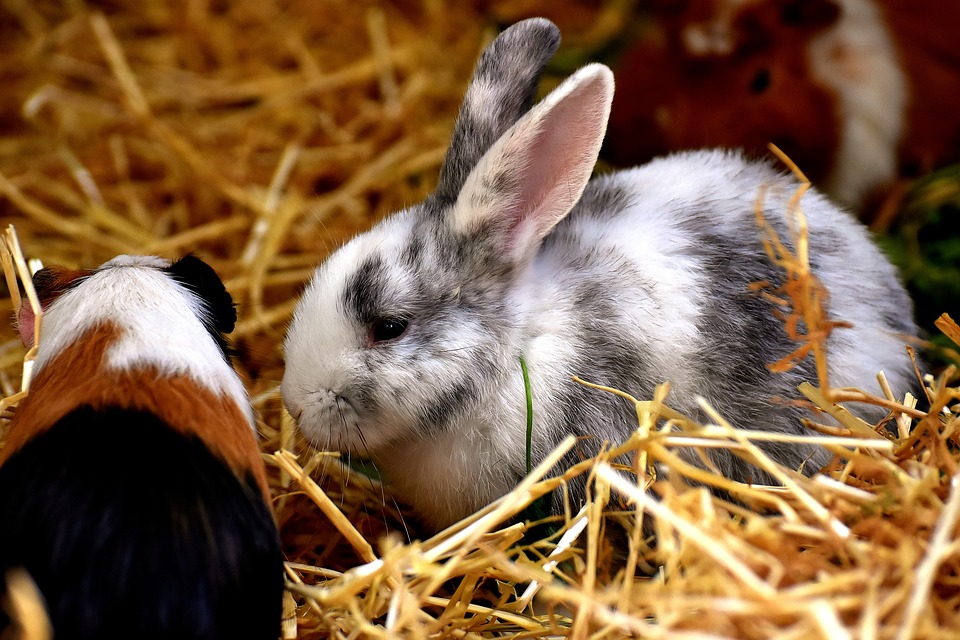 There is one way in which you and your family can take a headlong plunge into the rabbit world and begin to find out about it straight away. Go to a local rabbit show and you will find dozens of enthusiasts to talk to. Shows have stars according to their size and importance, but a local ‘one star’ show will be just as interesting as a bigger one.
There is one way in which you and your family can take a headlong plunge into the rabbit world and begin to find out about it straight away. Go to a local rabbit show and you will find dozens of enthusiasts to talk to. Shows have stars according to their size and importance, but a local ‘one star’ show will be just as interesting as a bigger one.
Fortunately, there is no danger of the colored rabbit breeds becoming extinct, as there has been with some breeds of pig until the recent ‘rare breeds’ revival. Commercial rabbit keepers like those in pigs, prefer white animals, or rather the market seems to demand them. But rabbits are not always kept for commercial reasons. There are fur varieties, kept for the pelt but yielding a useful carcass if not a gigantic one. And also, there is the ‘Fancy’. Many of the older rabbit breeds which were developed at the end of the eighteenth century are kept as pets and for exhibition, as a hobby by people who get no reward except the enjoyment that the hobby brings. Of course, if they are successful at shows the value of their rabbits will increase and they will be able to sell their stock to other fanciers.
The drawback to these fancy rabbits from a meat-producing point of view is that the carcass is smaller than that of the commercial rabbit, and the flesh of the colored breeds tends to be darker. This may not matter if you are going to use the meat yourself — and the flavor could be more interesting.
The choice of breed is wide. The British Rabbit Council and American Rabbit Breeder’s Association, for example, has a list of over 30 breeds to choose from. By visiting a show you can see the various breeds and make your own choice. Here are a few of the possibilities:
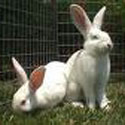 |
New Zealand White – This, in spite of the name, is an American rabbit with the acceptable white fur and flesh. It is a big rabbit, adult bucks weigh 9-11 lbs and does 10-12 lbs. Being larger, the does are blessed with 8 pairs of teats, ready to suckle a large litter. This rabbit bas round haunches and shoulders with a lot of meat on them. The bones are rather large however, which affects the meat to bone ratio – the worry of the commercial meat packers. It is actually an albino rabbit, with pink eyes. This can mean it is rather susceptible to changes in temperature. |
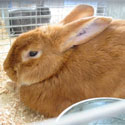 |
New Zealand Red – This rabbit is smaller than the White and is a reddish color. The bones are smaller and it is a good mother. For show purposes the breed is kept pure, but commercial breeders often use it with a white breed. The New Zealand of both colors has a national three-star show of its own, so it must have a lot of followers. |
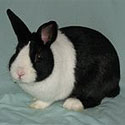 |
Dutch – This is a nice little rabbit, black with a white saddle, often seen as a children’s pet (and so perhaps one to avoid for the pot!). The rabbits are mainly kept for showing but although small, about 5 lbs, they have a value in the production of meat. The Dutch matures early and therefore produces meat quickly and the does make excellent mothers. |
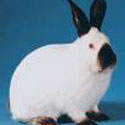 |
Californian – Here is another American breed. California seems to be the place for rabbits in America; no doubt the climate is just right. This is a rabbit often seen in Britain now; it was introduced in the 1960% by A.E. Moss. It is a round white rabbit with a black nose, ears, feet and tail. The adult weight is 10-12 lbs and this is another producer of white meat, this time with fine bones. |
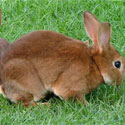 |
Rex – This is hardly a breed but rather a variation on several breeds. I have mentioned before the short velvety fur of the Rex varieties. It was a mutation which first turned up in France early this century. Rabbits appeared with no guard hairs (the long ones which project furthest) and no whiskers. The first one to appear was the castor rex, a wild rabbit gray type. After this, by selected matings many colors were developed. This called for much inbreeding and for a time the stamina of these rabbits was weakened. However it recovered in time and they are more or less as hardy as the rest now. Where the suffix ‘rex’ came from has been forgotten. These are very docile rabbits, compact and meaty, and weighing 6-8 lbs. With meat in view, these days they are used for crossing, but if they are bred pure, the pelts are beautiful if taken at the right time. So, if you want both meat and fur, try the Rex varieties. |
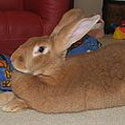 |
Flemish Giant – This is of Belgian origin, a heavy rabbit weighing 11-14 lbs. During the war this was a useful rabbit for meat from scraps. A good strain of this breed would be a useful backyard rabbit now. |
 |
Beveren – This is another Belgian rabbit. There are white and colored varieties and, of course, white is more popular for meat production. |
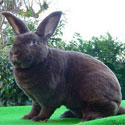 |
Havana – Another Dutch rabbit of a rich chocolate co lour. It is small, but very compact and meaty. |
These are only a few of the breeds available. If you go to a show or talk to people who keep rabbits you will begin to develop preferences and will gradually be able to decide what kind of rabbits to keep.
When you select your stock, the main things are health and vigor. Good breeders always keep records and it would be a good idea to ask to see the records of the parents of the stock you are buying – look for large families and quick growth. Perhaps even more important than large families is regular families. Regular breeding means everything to the commercial man and he hopes for at least 40 young rabbits in a year from each doe. Backyarders can expect less than this but it is a good plan to buy the best stock that you can get. They will not be forced under your conditions, but they will be with you for a good few years and so the best rabbits will be worth their money.
With regard to health, consult the chapter on the subject for details, but you should be able to tell at a glance whether you are inspecting healthy rabbits or not. Watch out for sneezes and snuffles. I have not spent any time on respiratory diseases in the notes on health because this should not be a problem of backyard rabbits kept in outside hutches. These diseases, such as rhinitis and pneumonia, are caused by civilization. Pigs and rabbits kept in intensive conditions get this sort of trouble but it is rare in outdoor stock. It results from infection and irritation of the nasal passages and lungs; avoid sneezing rabbits like the plague. Rabbits wiping their noses with their paws are pathetic, but these are difficult diseases to cure. Sometimes the air flow in large rabbitries is insufficient and ammonia fumes may build up and lead to this sort or irritation.
The age of the stock you buy will depend to a certain extent on what you are offered. Cheapest would be young rabbits after weaning, say at eight to ten weeks of age. This is really the best time to buy them. They will grow up with you and have time to get used to the food, housing and management you are giving them. This is important because does are nervous creatures sometimes, and they will not settle down in a new home right away. Easier to get hold of might be the usual breeding package of three does and a buck, aged about four or five months – ready for breeding quite soon.
The number of rabbits to start with depends on how much space you have available, but if you are a beginner with livestock it will be wise not to get too many at first. The usual thing is to get the nucleus of three does and an unrelated buck, at whatever age they come. If all goes well this will provide rather more rabbit meat than your family can get through in a year, unless you are very clever at juggling with recipes; but surplus meat can be exchanged for all kinds of goods and services from neighbors.
Pet shop rabbits are not a good idea. Nor is it wise to buy from someone who is giving up in despair! Rabbits have a bad name in this respect; commercial production has been called the eighteen month industry because of the numbers of people who start into it, full of hope, and give up before the end of the second year. I hasten to add that this has nothing to do with backyard rabbit keeping.
It is a good idea to visit the premises of the breeder from whom you are buying, if this is at all possible. Besides having a look at the stock and the records you can also study the management. It is always possible to learn something in this way and breeders in general are usually generous with time and information.
If you are offered accredited stock, this means that you are dealing with a serious commercial breeder. The Commercial Rabbit Association has an Accreditation Scheme, aimed at setting standards for commercial rabbitries. If you buy from an accredited breeder this should safeguard you against getting poor stock. The rules are quite strict and the CRA has an inspector who travels about the country, making sure that they are kept. The first rule is that any stock offered for sale must have been born on the seller’s farm. Others concern health, record keeping and standards of management. The CRA keeps a register of accredited breeders.
Another advantage of thoroughly spying out the land is that you will find out what sort of food and housing the rabbits are accustomed to. Changes should be introduced as gradually as possible to give the animals time to get used to them.
 A young rabbit will obviously get an enormous shock when it is taken away from its home in a box, probably put in a car, and tipped out into a strange hutch at the other end. One way in which you can cushion the shock a little is by giving the rabbits the same food as they were used to at home even if it means buying a few pellets from the owner to start off with. You may have decided not to feed pellets yourself, but change the food gradually. The same applies to the hay and green food – find out what is being fed and change things gradually.
A young rabbit will obviously get an enormous shock when it is taken away from its home in a box, probably put in a car, and tipped out into a strange hutch at the other end. One way in which you can cushion the shock a little is by giving the rabbits the same food as they were used to at home even if it means buying a few pellets from the owner to start off with. You may have decided not to feed pellets yourself, but change the food gradually. The same applies to the hay and green food – find out what is being fed and change things gradually.
Another point to watch for is the type of hutch floors. A lot of commercial breeders are now using hutches with wire floors and a tray underneath to catch the droppings. These are very clean and odorless but rabbits which are not used to them can get sore hocks on them and can also be made to feel nervous – and, as I said before, does do tend to be nervous. If they are not settled when the litter arrives, they tend to drop the babies anywhere in the hutch and fail to look after them. Newborn rabbits chill and die very soon if they are not in the nest.
It is estimated that one person can look after between 200 and 500 breeding does according to the set-up. Inevitably you may find in such a unit that the individual rabbit does not receive very much attention. Another advantage you will have over the large producer is that you can give them attention; and if you buy them young, they will get to know you before breeding starts.
The returns you can expect will depend on your management and also on the cheapness of the feed. A small amount of rolled oats and some bran may need to be bought, but greenfood should be obtained free, and with luck you should be able to make your own hay. Ask your greengrocer for cabbage leaves and so on; he may be delighted to get rid of them.
It is possible that your surplus rabbits could be sold to pay for the outlay on bought-in food. If the game dealer I mentioned is right, rabbit meat could be in demand soon and if you cultivate an outlet who will take your stock live, and save you the trouble of killing and dressing (and the bother of regulations about the premises for these activities), this could provide a valuable income.
Efficiency on the backyard system will not be so vital as in a big rabbitry – after all, we are trying to avoid stress for the animals and for ourselves, not cause it! But if you are going to do the job it will be more satisfying to do it well. So it will be worth your while to keep records and to chart your progress from them. A good commercial yardstick is the amount of food consumed per lb of live weight produced. This may be difficult to measure if you are feeding green stuff and scraps, but it is comparatively easy to calculate for the pellet feeders.
To measure efficiency, you will need some kind of tally of what you spend and put into the enterprise on the one hand and what you get out on the other. It is interesting to know the average live weight of the rabbits you kill or sell for food, the food costs, and the price of rabbit meat – even if you use it rather than selling it. And if you don’t use pellets an up to date knowledge of the price of them is a yardstick against which to measure your own food costs and the effort you put into finding cheaper foods.
A rough guide to success or otherwise with meat producing animals is the yearly margin over food costs per breeding doe. Typical figures in a report I have seen, varied from just under $9 per doe per year to just under $17. Inflation will have altered these figures but the wide variation will no doubt remain; it was according to the numbers of young produced, which varied from 30 for the low profit farms to 50 per doe.
Commercial enterprises have far more overheads than the backyard producer, so you can always take an optimistic view!
Another rough guide – the price of dressed rabbit at the time of writing is 75 cents per lb retail. So a 2¼ lb carcass is worth £$1.69. Multiply this by the number of young.
Costs for a commercial unit are obviously changing all the time and any figures given are soon out of date. Then again, the money you put into your rabbits will not bear much relation to the capital investment required for the bus-i ness of rabbit production. It may be of academic interest to note that it can cost $57 per doe to house rabbits in a new building. Wire cages cost from $4 to $11.
Commercial stock costs from $7 per doe from a reputable breeder; the young rabbits are weaned at about 4 weeks and sold at about 10 weeks, about 5 lbs live weight. They will need 3.25 lbs of food for every 1 lb of meat produced. This is an overall figure to include the cost of food for the parent rabbits. One merchant tells me rabbit pellets are roughly 7 cents per lb, in other words the cost of putting on one lb of meat is 23 cents. The price obtained (live) is about 42 cents per lb so the margin is 19 cents per lb over food costs.
I know from experience, having done the family accounts for a long time, that slight movements upwards of costs and downwards of returns can squeeze out the profit of any livestock enterprise at any time. Added to this, there is the possibility of disease or failure to breed to contend with. So there is little likelihood of getting rich quick with any type of animal. But I believe the job to be worthwhile for two reasons. Firstly, you can avoid the money economy because you are producing food you can use yourself, more cheaply than it can be produced commercially and sold to you; nobody makes a profit out of you. Secondly, backyard animals, particularly rabbits, represent a means of getting something out of what would otherwise be wasted; scraps, greenfood, lawn mowings – a really sound antidote to our throwaway civilization. If everybody in the country suddenly decided to make use of neglected scraps, the economy would change. It seems to me there is almost a moral duty in this direction.
To get back to our start with rabbits. Another point to remember is that recording is impossible unless you can identify the breeding rabbit. Even if you have only three it would be quite easy to get them mixed up if they were all the same breed and the same age.
Tattoos and ear tags are sometimes used for identification – obviously this is a bigger problem for the commercial people than it will be for you. Rabbit rings are probably the best for a small outfit. The British Rabbit Council supplies rings in different sizes for the various breeds. The ring is engraved with the initials BRC, the year and the serial number. It is slipped onto the hind leg of a young rabbit at about eight weeks and it goes on over the hock and stays on the upper leg. It is quite slack and comfortable, but it won’t come off. After about ten weeks the hock has grown too much to allow the ring to be slipped over it. This means that you have to decide quite early in the rabbit’s life whether or not it is to be kept for breeding, since only the breeding stock is ringed.
These rings are compulsory if you wish to exhibit rabbits at shows in Britain – on the continent, tattoos are used. Rings were imposed by the BRC to put an end to the confusion and even cheating which had occurred at shows. People would lend their best rabbits to others to show and some-times good rabbits were stolen. Alternatively the stewards would get mixed up and put the entries in the wrong cages, and without identification marks it would take hours to sort them all out.
Another advantage of rings is that they identify lost rabbits. The BRC is frequently contacted by someone who finds a tame rabbit hopping about. If it has a ring number, the owner can be traced.
When you go to inspect rabbits it will be as well if you know how to handle them. Watch the owners and the judges at shows, to get to know how it is done. They do it gently but firmly, with no sudden movements. Put your hand into the cage slowly, grasp the rabbit by the ears with one hand and put the other hand under the haunches to take the weight.
It will be necessary to make some preparations before your rabbits are due to arrive. Hutches and food supplies should be ready for them. In the next section we will consider the different types of housing which can be used.
- Why Why Keep Rabbits?
- Rabbits Past and Present
- Some Basic Information
- Making a Start
- Housing
- Feeding
- Growing Crops for Rabbits
- Breeding
- Health
- Harvesting the Wild Rabbits
- The Harvest
- Using Rabbit Meat
- Fur Production
- Showing
- Angoras
Further Research:
   |